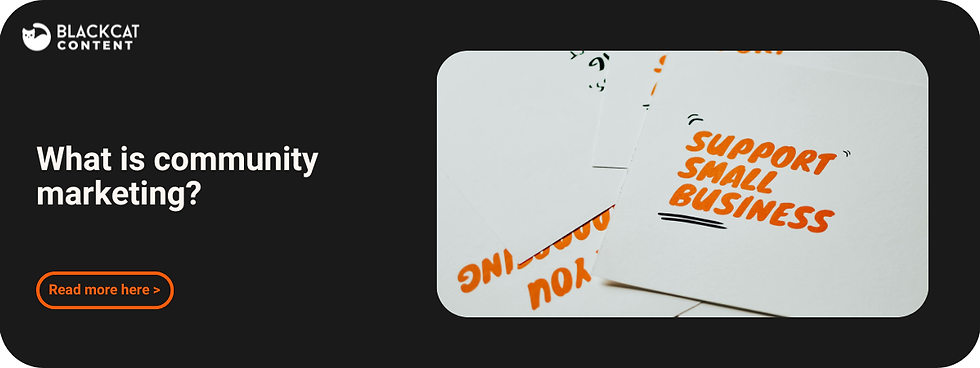How to use AI in your content marketing strategy
- Tabitha Clicksworth

- Oct 9
- 4 min read
Updated: Oct 25

AI is literally everywhere at the moment, especially in marketing and it’s no longer a futuristic buzzword, it’s actively reshaping how top brands operate. Just last week, in September 2025, JPMorgan announced its plan to become the world’s first fully AI-connected megabank, giving employees AI assistants to speed up tasks like investor presentations and compliance work.
And Citi has just mandated AI prompt training for over 175,000 employees. For marketers, these developments signal a clear trend: AI isn’t just a tool, it’s a fundamental shift in how organisations operate. And just as financial giants are embedding AI into every process, content marketers can harness AI to create smarter strategies, scale content production, and deliver more personalised customer experiences.
Why you should use AI in content marketing
Before diving into steps, it helps to understand what AI brings:
Speed and scale: AI can automate repetitive tasks (e.g. topic ideation, outlines, tag generation), freeing your human writers (like us) to focus on strategy and voice.
Personalisation: AI can help tailor content to individual user segments, delivering the right message at the right time.
Data-driven insights: AI analytics can surface patterns in content performance, user engagement, keywords, and more.
Competitive edge: Early adopters can outperform peers by reducing costs and iterating faster.
That said, the output of AI is only as strong as the strategy, data foundations, and human oversight around it.
Steps to integrate AI into your content marketing strategy
1. Audit your workflow and identify AI opportunities
Start by mapping your current content process: idea generation → research → drafting → editing → optimization → distribution → performance monitoring.
Ask yourself: Which steps are repetitive, time-consuming, or data-heavy? That’s where AI can add value (e.g. keyword clustering, topic discovery, draft generation).
Also, assess your content inventory and gaps. AI tools are more effective when paired with a well-structured content backbone (topic clusters, pillar pages, taxonomies).
2. Choose and test AI tools for creation and optimisation
There are many AI tools in the marketplace (Jasper, Copy.ai, ChatGPT, Writesonic, SurferSEO, etc.).
Use them initially as assistants, not replacements: generate first drafts, prompt for outlines, experiment with variants.
Combine with SEO tools: use AI for suggestions on keywords, LSI (latent semantic indexing) terms, title permutations, meta descriptions.
Test performance: A/B two versions e.g. AI-assisted vs. fully human, to see what resonates with your audience.
3. Layer AI into SEO & topic strategy
AI can help with:
Keyword clustering: grouping synonyms, long-tail variants, and thematic terms.
Topic modeling: discovering subtopics you may not have covered.
Content gap analysis: spotting areas your competitors cover but you don’t.
SEO Optimisation: suggesting headings, internal links, alt text, and more.
But don’t blindly follow AI’s suggestions, always validate against search intent and human judgment.
4. Use AI for personalisation, automation and dynamic content
Modern content strategies benefit when AI helps deliver the “right content to the right user.” Some possibilities:
Dynamic content: adjusting headlines or calls-to-action based on user behavior or profile.
Recommendation engines: suggesting related content or next steps.
Chatbot-driven content: embedding AI-powered assistants that offer content or answers in real time.
5. Monitor, evaluate and iterate
AI gives you the opportunity for more rapid experimentation, but as with most marketing tools, needs rigorous performance measurement:
Track KPIs: page views, CTRs, time on page, conversions, bounce rates, scroll depth.
Drill down by content version: which AI prompts or tool settings produced better engagement?
Retraining & feedback loops: feed results back into your prompts or models to refine outputs.
Remember, always keep a human editor or strategist in the loop to catch tone issues, factual errors, or bias!
Common challenges with AI
Overreliance on AI
Too much AI can lead to bland, uniform content. Always inject human voice, stories, and nuance.
Factual errors and hallucinations
AI can invent details. Always vet and fact-check.
Bias and fairness
Be careful of content that inadvertently amplifies bias. Use diverse training data and review outputs.
Data privacy and compliance
If your AI uses user data or sensitive information, make sure it respects regulations (GDPR, CCPA, etc.).
Change resistance
Team members may fear replacement. Frame AI as augmentation, not substitution.
Example of an AI-powered content marketing strategy
Here’s a quick sample plan showing how you might mix AI and human effort over a quarter:
Over time, refine prompts and AI settings so the system itself becomes smarter.
Implement AI into your marketing strategy today
AI is rapidly transforming how organisations plan, produce, and personalise their content. But as the examples of JPMorgan and Citi show, success doesn’t come from technology alone, it comes from having the right strategy, the right training, and the right partners.
That’s where BlackCat Content comes in. We’re a content marketing agency that isn’t scared of AI and helping our clients successfully implement it into their content marketing strategy to save time and money.
We can help you integrate AI into your day-to-day marketing in ways that are practical, ethical, and results-driven. From building AI-powered content strategies to training your team on prompt best practices, we make sure you stay ahead of the curve without losing your brand’s unique voice.
If you’re ready to future-proof your content marketing and put AI to work for your business, get in touch with BlackCat Content today.







Comments